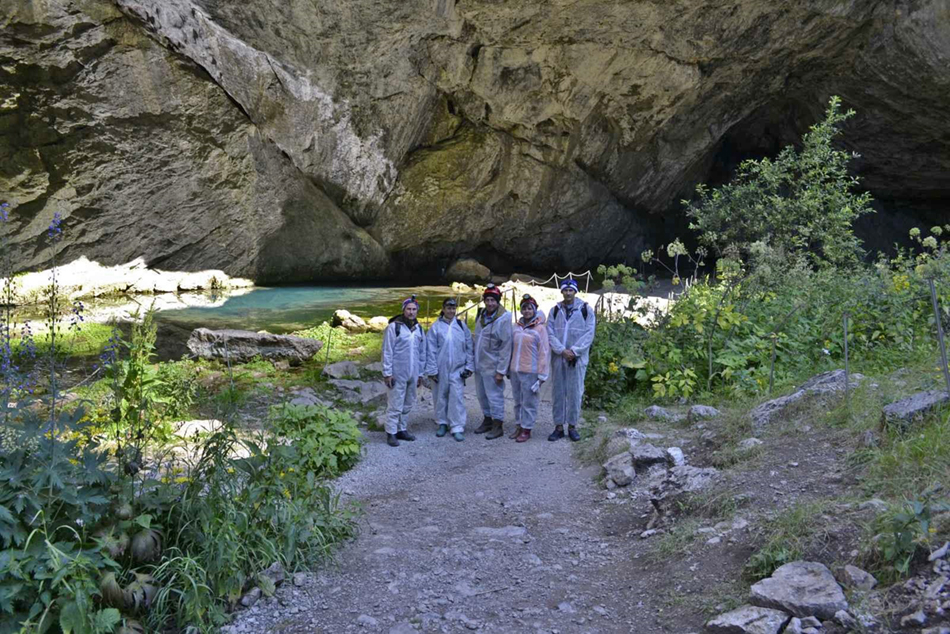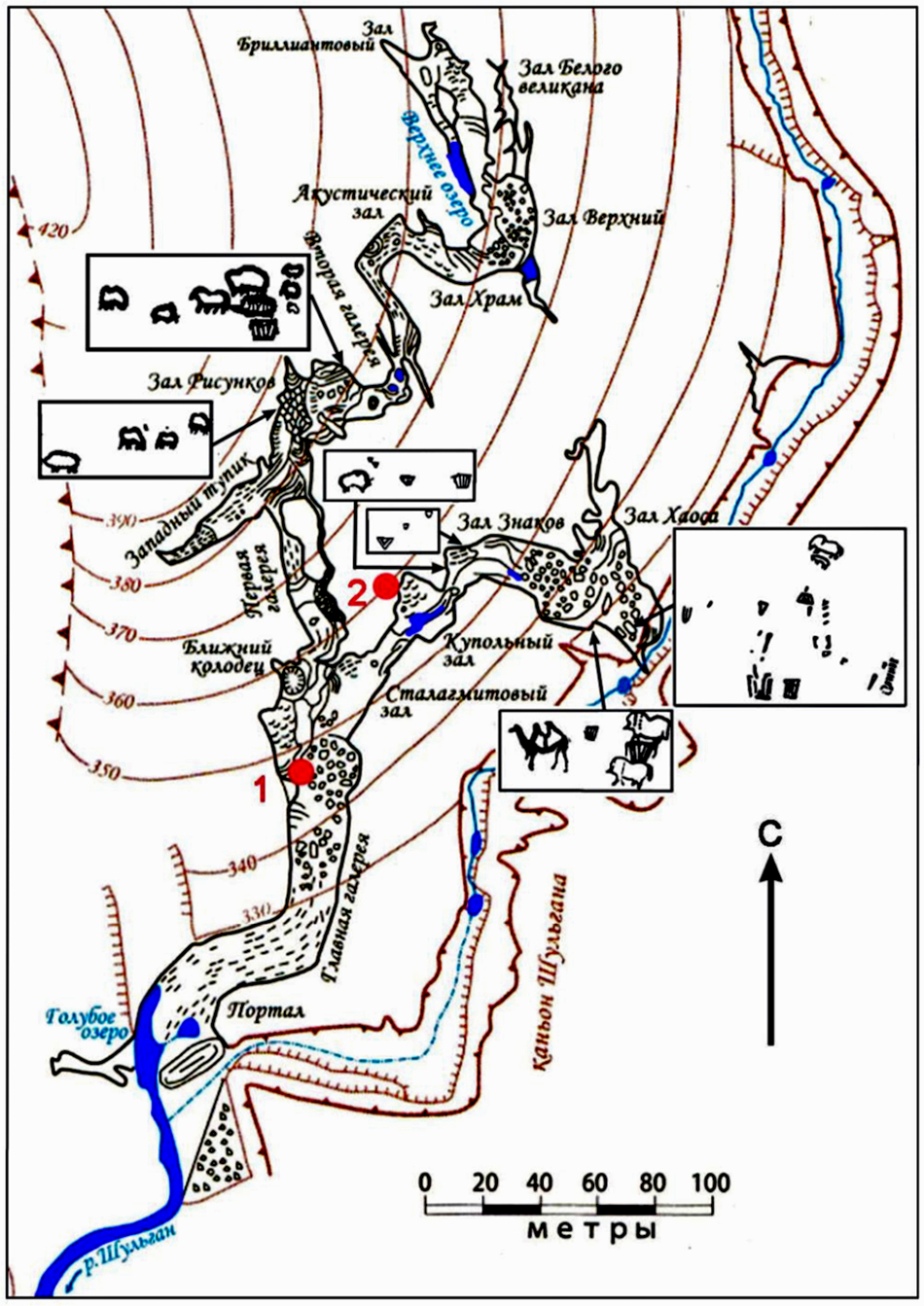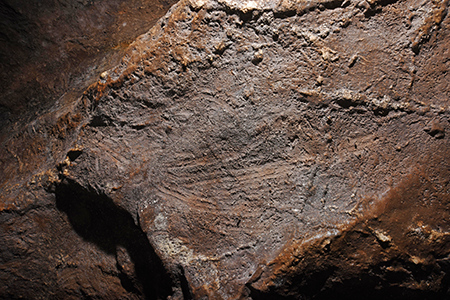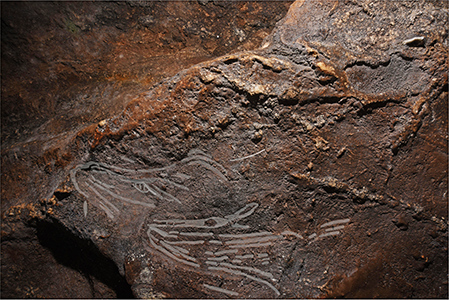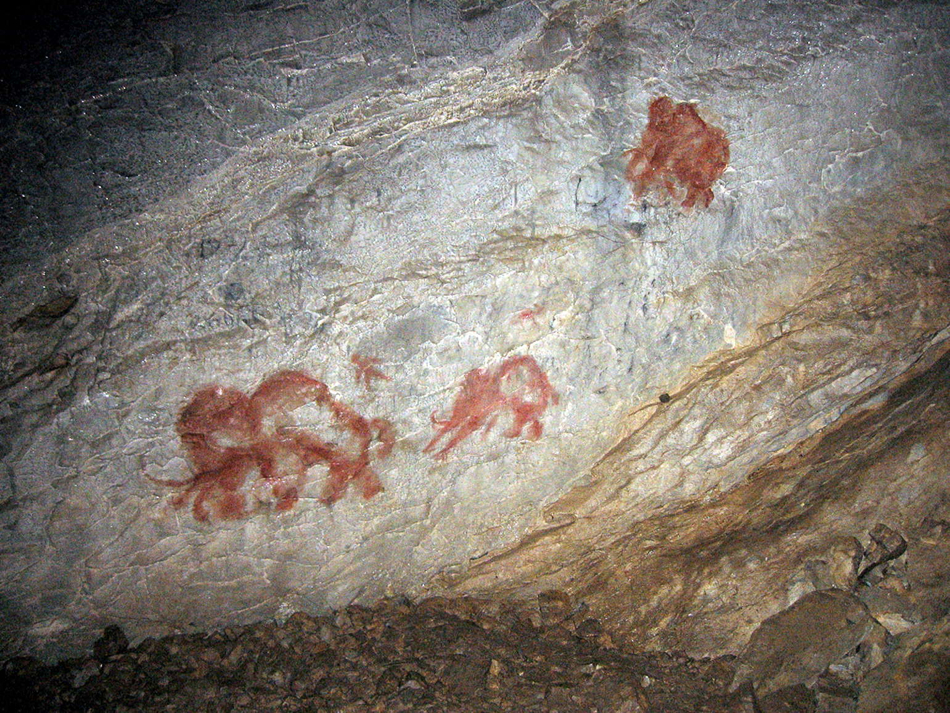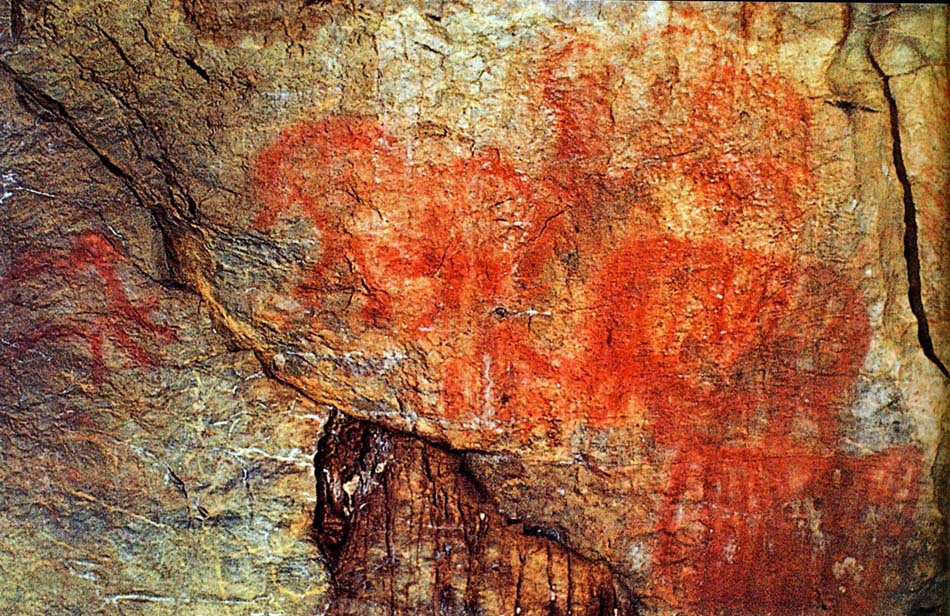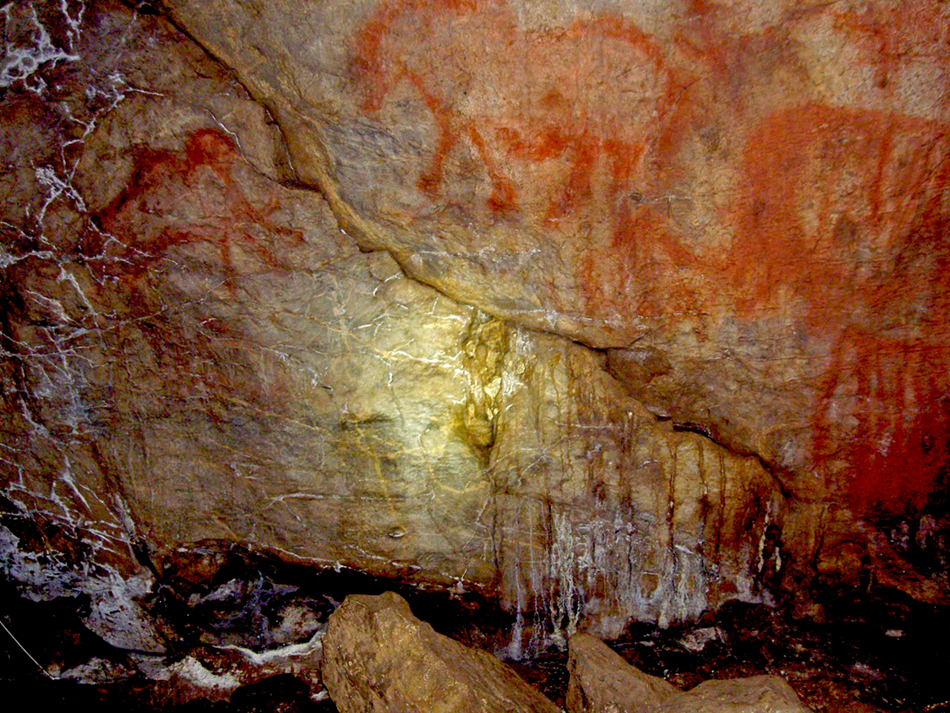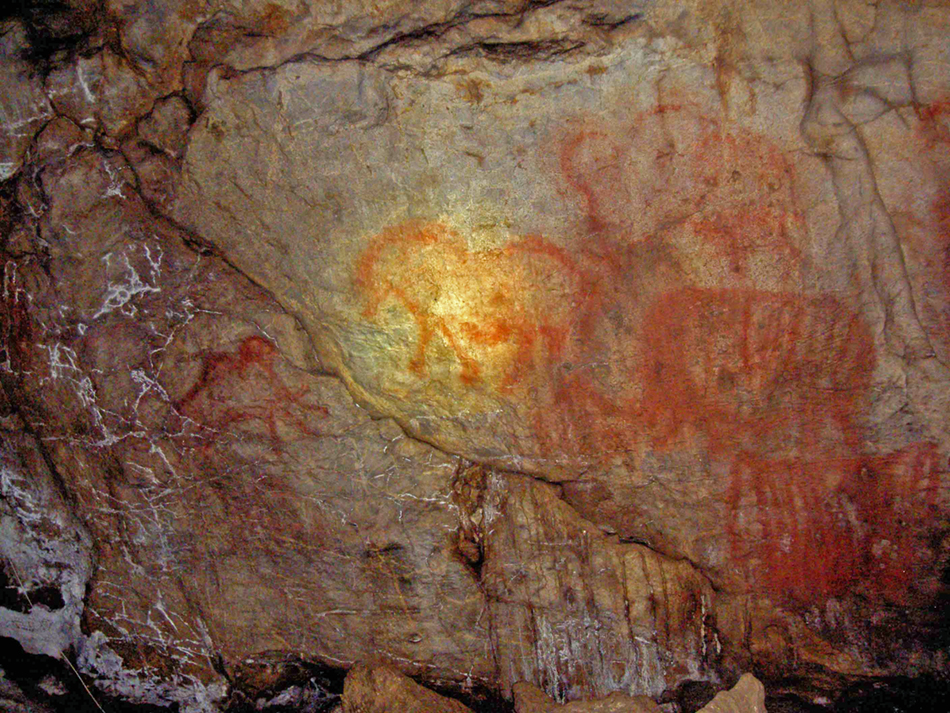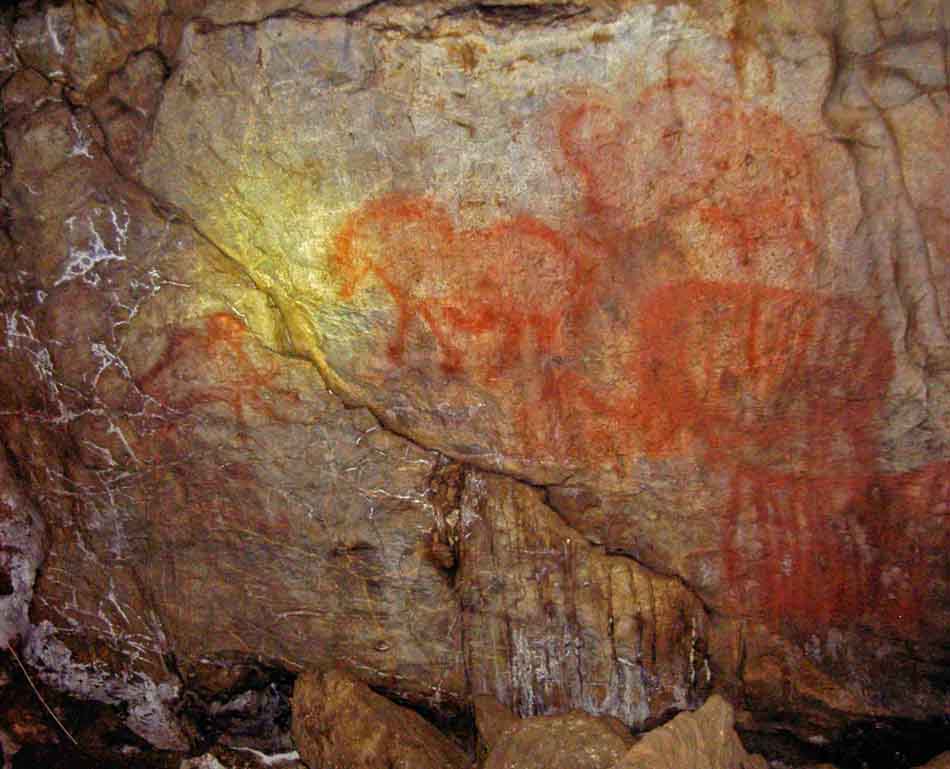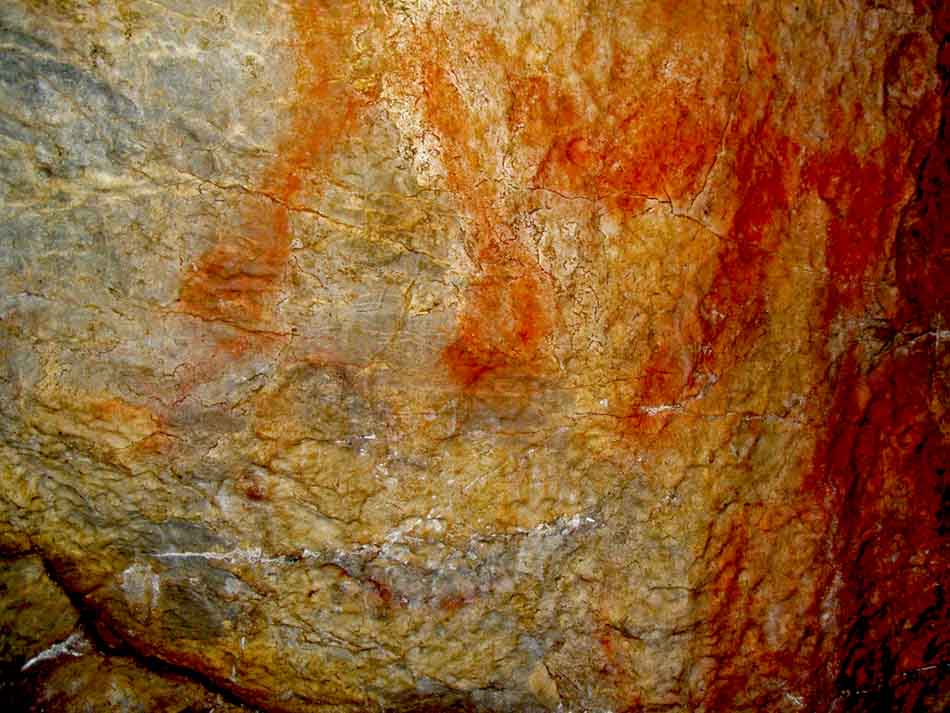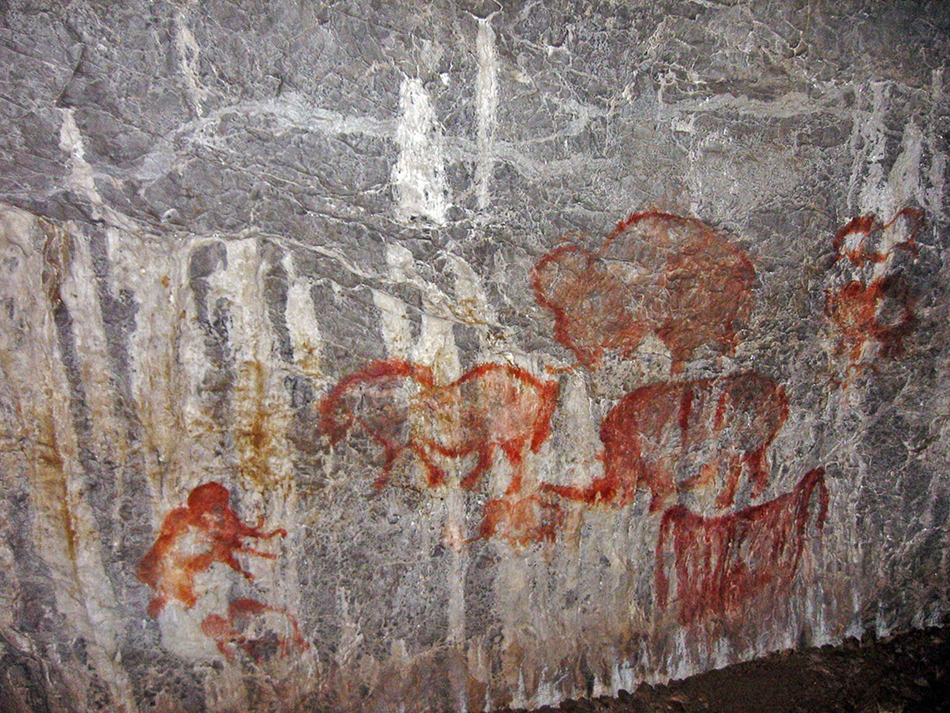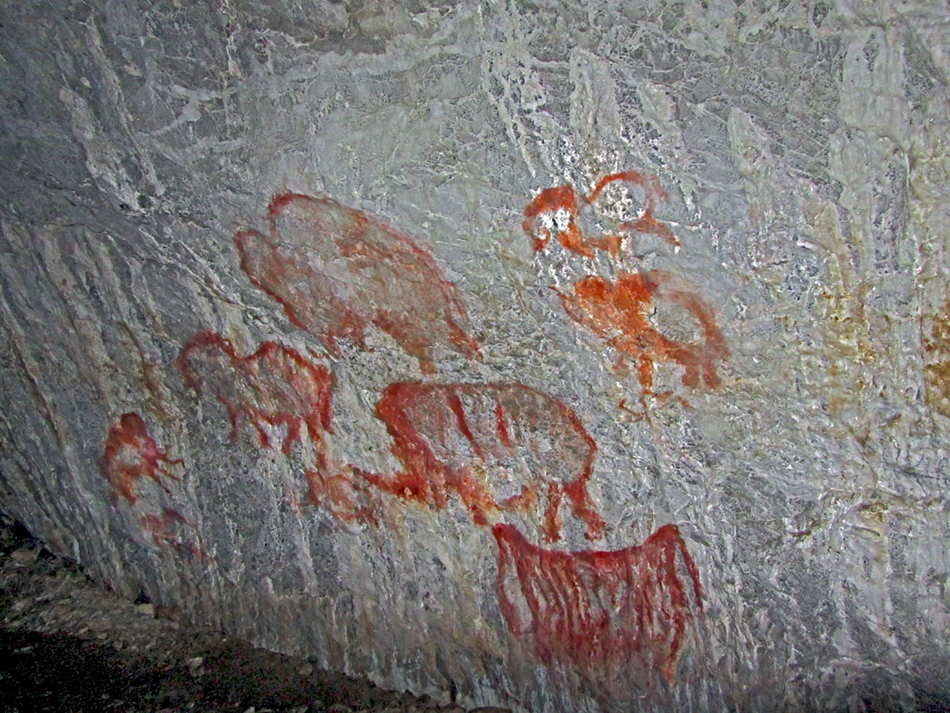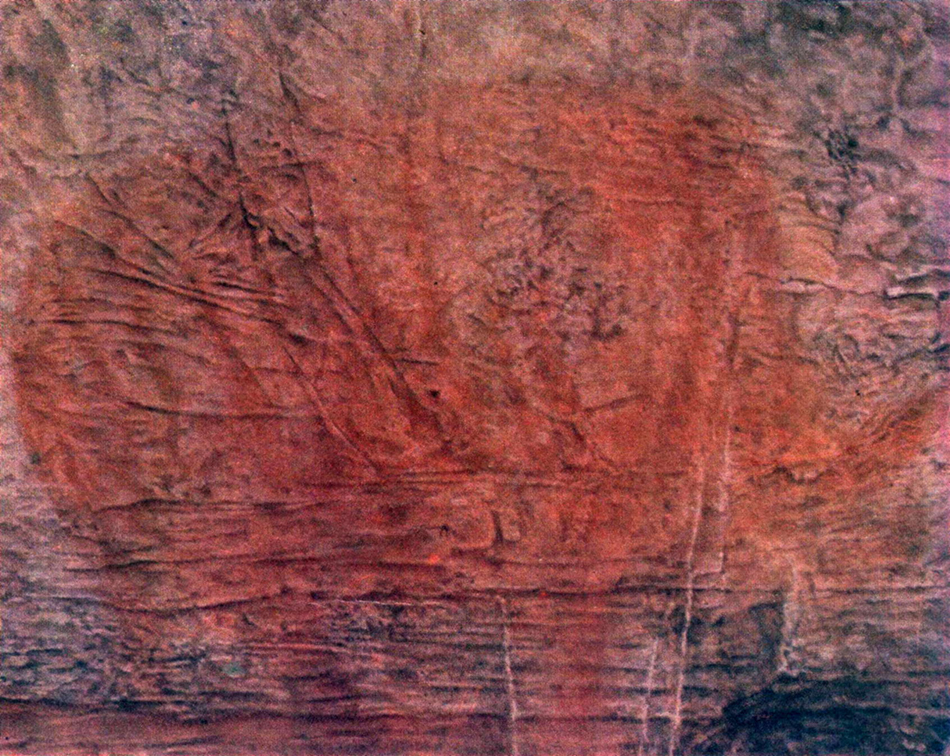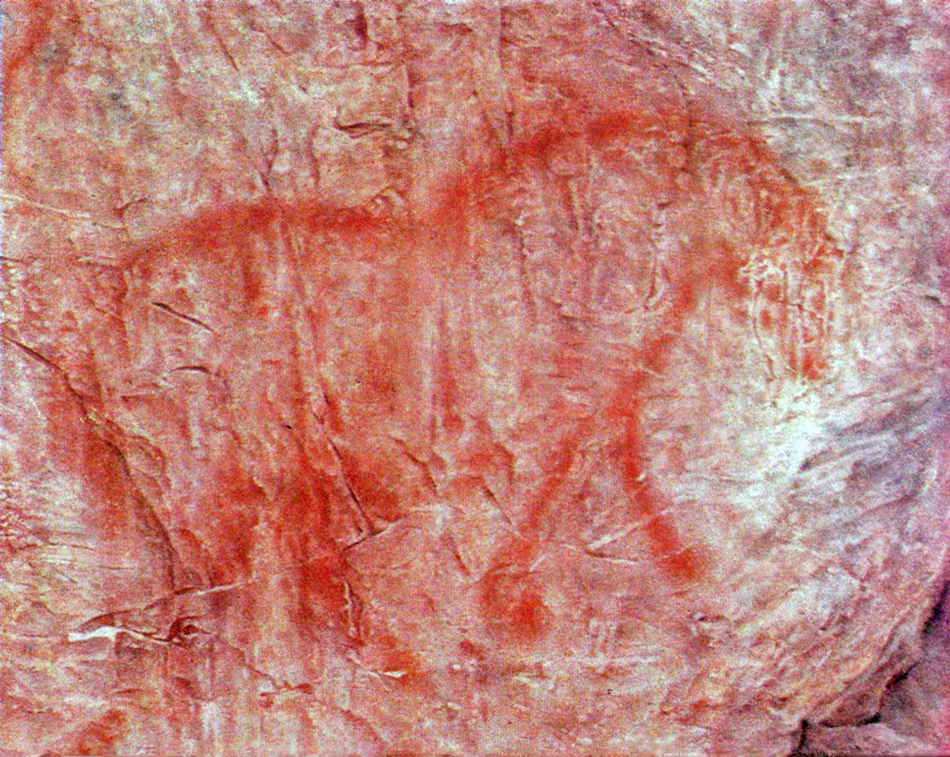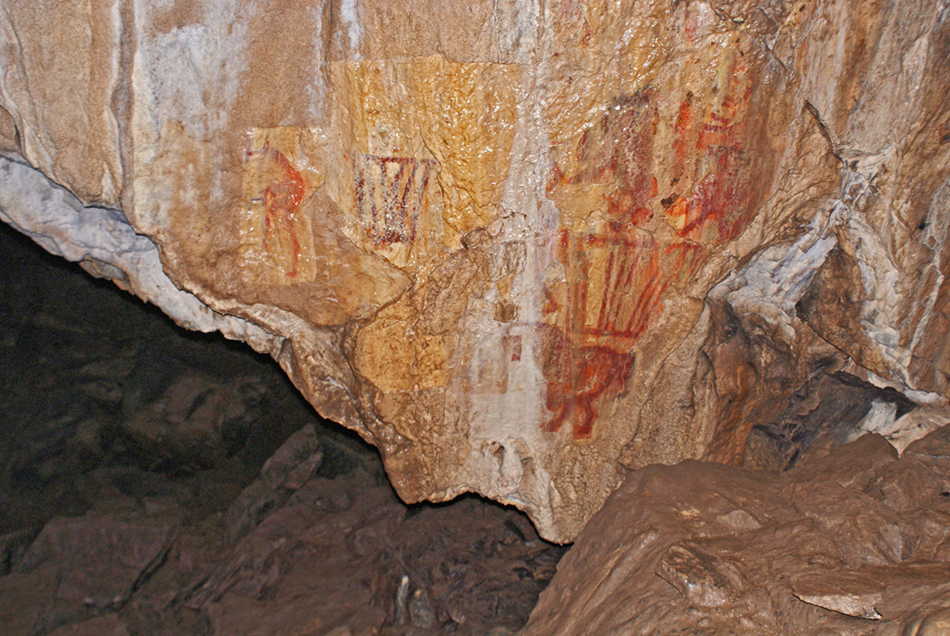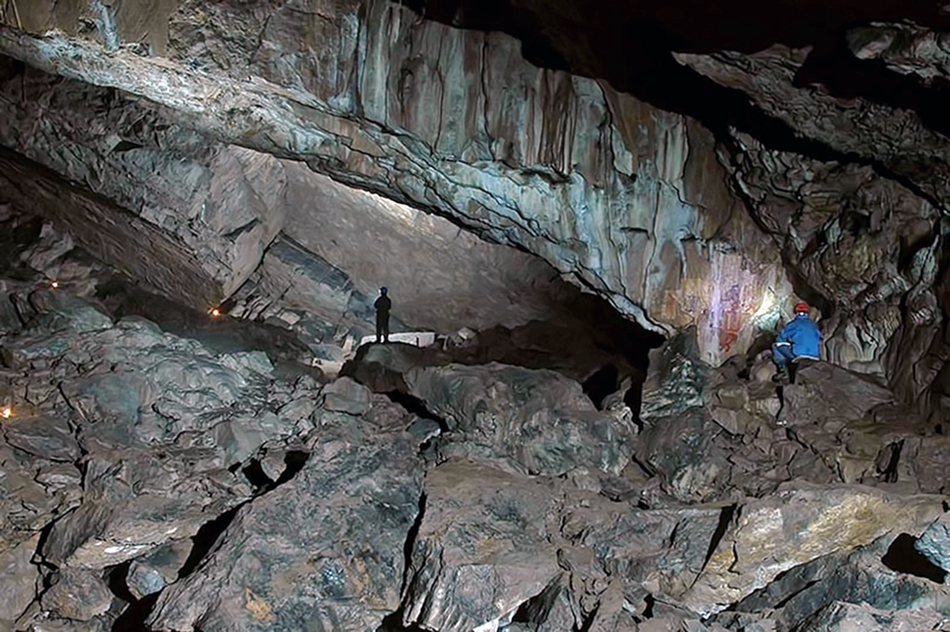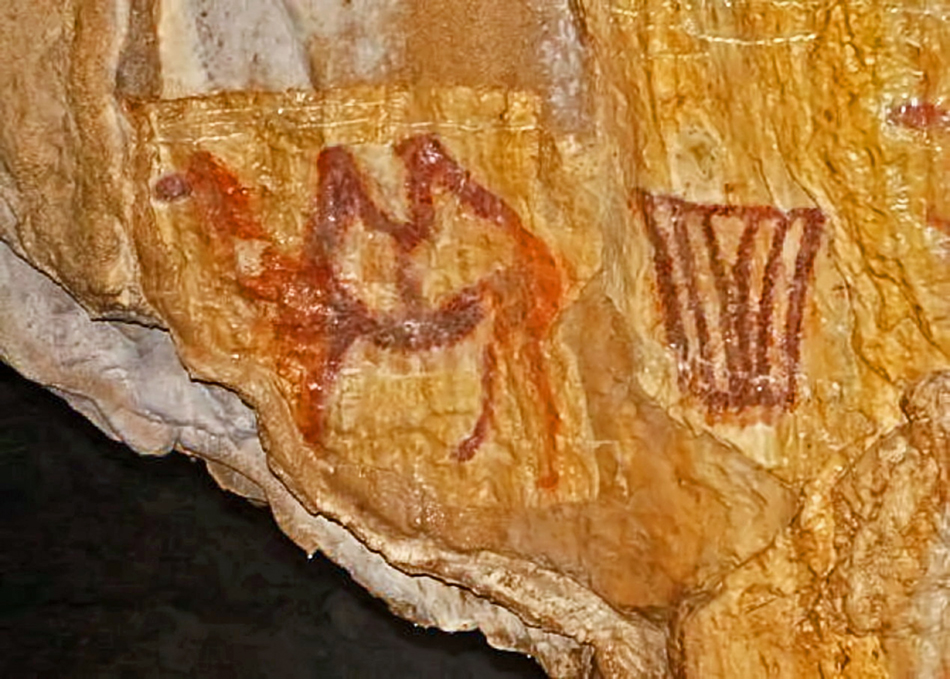Back to Don's Maps
 Back to Archaeological Sites
Back to Archaeological Sites Kapova Cave
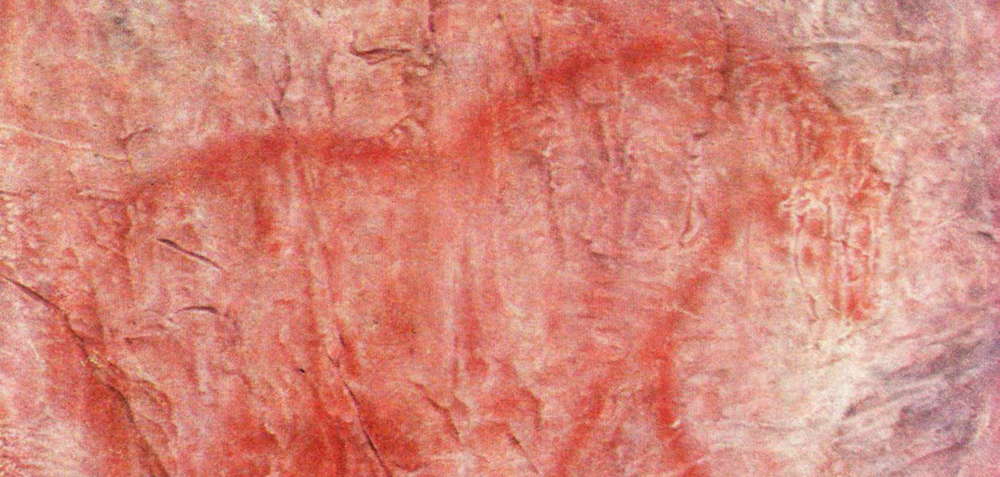
Kapova Cave is a famous Russian Palaeolithic cave. It has painted mammoths, rhinos, horses and a bison on its walls. They were dated by O. N. Bader as being from the end of the Upper Palaeolithic. The cave has two levels, the paintings are mainly in the upper level at some distance from the entrance. This fact is typical for palaeolithic paintings and a source for speculation about the meaning of the paintings. Excavations revealed a layer with human remains, debris from the wall paintings, animal bones and charcoal. The charcoal was dated with the 14C method to be 14 680 ±150 years old. Among the animal bones were cave bear bones. Kapova Cave is a complex natural monument with multiple grottos and halls connected by passages on various levels. The walls of the cave are rich in calcite deposits of all kinds of forms and sizes. An underground river flows out of the cave and forms the Blue Lake at its entrance. It is named after the blue colour of the water, caused by the high amount of lime in the water, which is best seen on sunny days around midday, when sunlight shines into the cave and on the lake.
Photo: Horse, Kapova Cave, Abramov et al. (1984)
Text above adapted from http://www.showcaves.com/english/ru/caves/Kapova.html
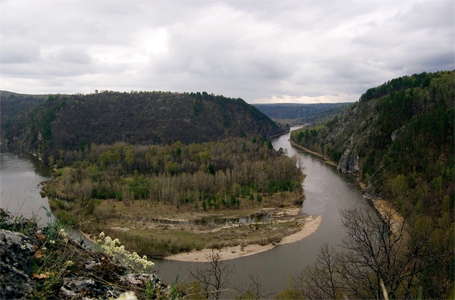
This is the sharp bend of the Belaya River in the Shulgan-Tash nature reserve, near where Kapova Cave is situated.
Photo: drews via Panoramio.
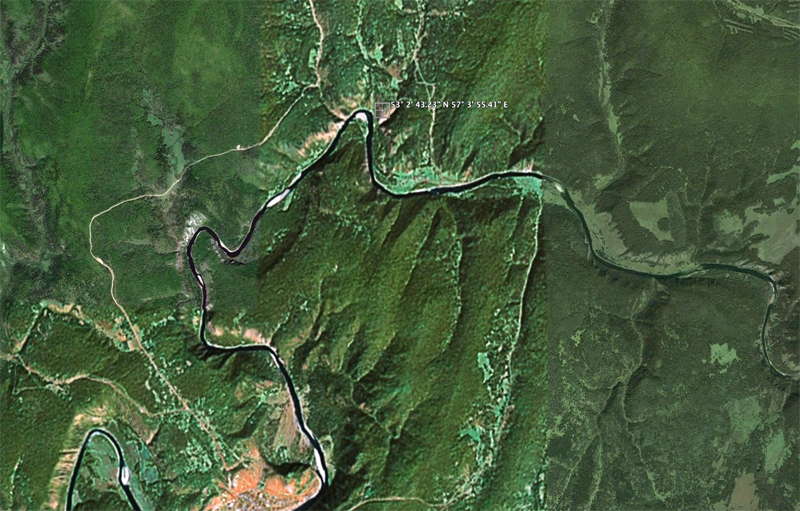
Kapova Cave marked with its latitude and longitude on the Belaya River in the Shulgan-Tash nature reserve.
Photo: Google Earth
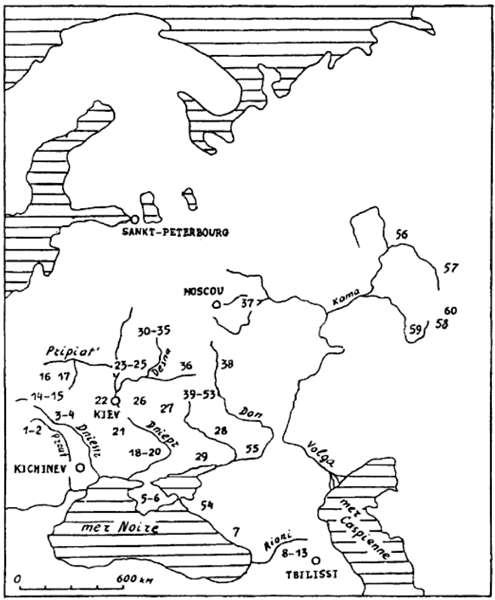
Distribution of mobile art in Eastern Europe.
1 Staryé Duruitory, 2 Brynzeny, 3 Kosseoutzy, 4 Klimaoutzy, 5 Suren' 1, 6 Chan-Koba, 7 Apiantcha, 8 grotte d'Uvarov, 9 Sakagia, 10 Sagvardgilé, 11 Gvardgilas-Kldé, 12 Devis-Khvreli, 13 Taro-Kldé, 14 Molodova V, 15 Lissitchniki, 16 Lipa VI, 17 Klinetz, 18 Ossokorovka, 19 Dubovaya Balka, 20 Kaïstrovaya Balka, 21 Mejiritch (Mezhirich), 22 Kievo-Kirillovskaya, 23 Mézine (Mezin), 24 Novgorod Severskyi, 25 Puchkari I, 26 Dobranitchevka, 27 Gontzy, 28, Rogalik, 29 Amvrossievka, 30 Eliseevitchi I, 31 Eliseevitchi II, 32 Yudinovo, 33 Khoylevo II, 34 Timonovka, 35 Suponevo, 36 Avdeevo, 37 Sungir', 38 Gagarino, 39 Kostienki 19, 40 Kostienki 21, 41 Kostienki 13, 42 Kostienki 1, 43 Kostienki 14, 44 Kostienki 12, 45 Kostienki 17, 46 Kostienki 2, 47 Kostienki 11, 48 Kostienki 4, 49 Kostienki 15, 50 Kostienki 9, 51 Kostienki 8, 52 Borchtchevo 1, 53 Borchtchevo 2, 54 Ilskaya, 55 Murakovka, 56 Ostrovskaya, 57 Bez'imyannyi, 58 Smelobskaya, 59 Kapova, 60 Ignatievskaya.
Photo: Abramova (1995)

Kapova Cave entrance.
Photo: Ivan Shkalikov via Panoramio.
Kapova Cave entrance.
Photo: Courtesy of Dr Pavel Kusnetsov and Gail Brownrigg
Kapova Cave plan.
Plan of the Shulgan-Tash (Kapova) cave without the New Section with diagrams of the main clusters of drawings. The red dots indicate the locations of the engravings: 1 — composition No. 1 in the Main Gallery; 2 — composition No. 2 in the Dome Hall.
Based on: plan by Lyakhnitsky et al. (2013) with the author’s addition.
Proximal source: Kotov (2023)
Important recent discoveries
Alexey Solodey writes, 2019.08.23:I am glad to inform you that this summer in Kapova cave we found a new complex of images, which are engraved on the ceiling of low passage right before the Hall of Kupol, the first decorated hall of the ground floor of the cave. Now it is the second decorated one. On a region of approximately 10x15 metres we found about 30 panels with at least 50 depictions of animals. Most of the images were made with bare fingers in the soft substratum on the ceiling (we call that technique 'macaronis'), with artistically used natural forms of the relief of the rock – natural or corrected by humans. The height of the ceiling is circa from 1 to 3 m. Most of the images represent heads of an animal. Dimensions of the heads are circa from 20 to 60 cm. There are heads of horses, bear, deer, aurochs and possibly other animals. There are some full corpora depicted also: all of the mammoths (from 5 to 8 in number), two or three aurochs and several horses. There are images made with other techniques also: thin engravings, and black painting.
Due to the discovery we now have a completely different portrait of Kapova as a rock art site. Firstly, we have increased the number of images, and it is particularly important that they can be interpreted, for we know that no more than a quarter of known images in the cave could be 'read' before. And we have some new species in the art of Kapova now. Secondly, we have a new technique, which was known only in 'very Palaeolithic' sites in France and Spain before, as Pech Merle, Bara-Bahau, Chauvet etc. Then, we have some keys to other images in Kapova, which we had counted before as 'unreadable'.
A particular characteristic of the complex is that you cannot document it with using of any of the contact methods: the surface seems to be soft still. And more, even some of our non-contact approaches and methods have been improved dramatically: it is mostly about the technique of illuminating when documenting.
Some traces are patinised well. I think that we have up to four types of traces in context of colour differences and up to four types of differences in coating upon the traces. Some of the traces look quite freshly-made, though I think this is just a first impression which remains to be accurately proved.
Most of the animals have eyes. Very beautiful eyes sometimes, some of which have reminded us of examples from Font-de-Gaume, Niuax or Rouffignac. We don’t have anything comparable in the art of the Bronze or Iron Ages, as far as I can see. Sometimes they used a natural part of the substrate to be an eye, sometimes they made the eye with finger-engraving.
I attached two of the images, which 'agreed to be pictured', for most of them this is very hard to do. The first one we named 'The bear', pay attention that there are several heads made one inside the other, and the biggest one is the zoomorphic natural form: kind of Matrjoshka style, so to speak. I also attach a tracing of 'The goat', as we named it, though firstly it was a wolf, as I can remember, then it became a goat, and finally it seems to be a deer due to horns, which are now traced badly and hard to see in the photo. It is the result of two shooting attempts and two tracing attempts of the images of 'The goat' panel, and it is not the last. All the images of the complex are to be carefully traced digitally, but it’ll take some time.
So, come and see it for yourself. For us it was a miracle, and it remains so.
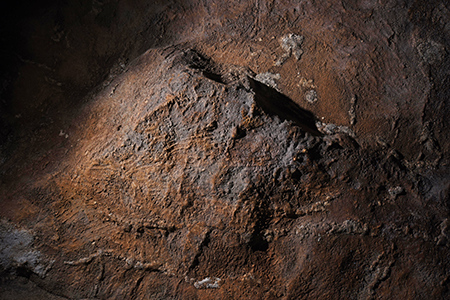
'The Bear', macaroni style.
Photo: Alexey Solodey, 2019
'The Goat', macaroni style, and a digital tracing of the artwork.
Photo: Alexey Solodey, 2019

Kapova Horses.
Photo: Scelinskij and Sirokov (1999)
Proximal Source: http://www.ceara.ru/
Проксимальный источник: http://www.ceara.ru/

Mammoth, Kapova Cave.
Photo: Abramov et al. (1984)
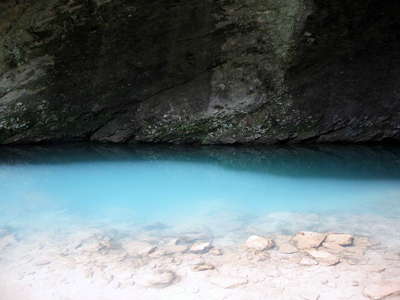
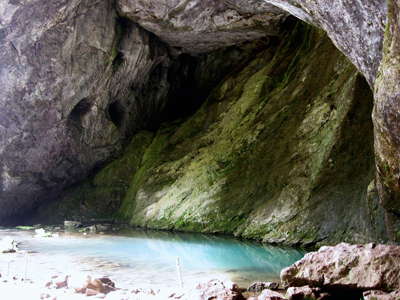
Kapova Cave Blue Lake, the lime in the water making the lake blue when the sun shines on it.
Photo: Ivan Shkalikov via Panoramio.
Mammoth, Kapova Cave.
Photo: Abramov et al. (1984)
Kapova Cave, paintings of mammoths.
Photo: Ivan Shkalikov via Panoramio.
Horse, mammoth and rhinoceros painted in red in Kapova cave.
Photo: http://www.arretetonchar.fr/
Horse, mammoth and rhinoceros painted in red in Kapova cave.
Photo: Courtesy of Dr Pavel Kusnetsov and Gail Brownrigg
Horse, mammoth and rhinoceros painted in red in Kapova cave.
Photo: Courtesy of Dr Pavel Kusnetsov and Gail Brownrigg
Horse, mammoth and rhinoceros painted in red in Kapova cave.
Photo: Courtesy of Dr Pavel Kusnetsov and Gail Brownrigg
Closeup of the horse in the image above.
Photo: Courtesy of Dr Pavel Kusnetsov and Gail Brownrigg
Kapova Cave, paintings of mammoths, a horse, and a rhinoceros.
Photo: Ivan Shkalikov via Panoramio.
Photo taken in Burzyanskiy, Republic of Bashkortostan, Russia
Another version of the panel above.
Photo: SaganZ
Permission: Creative Commons Attribution-Share Alike 4.0 International license.
Source: Wikipedia
Wooly Rhinoceros, Kapova Cave.
Photo: Abramov et al. (1984)
Horse, Kapova Cave.
Photo: Abramov et al. (1984)
Horse, camel(?), and signs.
Photo: Vladislav Zhitenev/Lomonosov Moscow State University
Proximal source: https://phys.org/news/2017-11-scientists-upper-paleolithic-cave-camel.html
This is the setting for the panel above.
Photo: Alexey Solodeynikov
Source: http://www.ceara.ru/
Double humped camel, Kapova Cave.
An ancient image of a two-humped camel has been discovered in the Kapova cave (Southern Urals). The age of the painting is preliminarily estimated to be between 14 500 and 37 700 BP, a time when there were no camels in the Southern Urals. This discovery confirms researchers' belief that artists in the Upper Paleolithic could migrate over long distances.
The image of a camel's shape is painted in red ochre and partially outlined with charcoal. This unique discovery was made by Eudald Guillamet, a well-known restorative specialist from Andorra, who was invited by the State Office of Protection of Cultural Heritage of Bashkiria to clean the cave of graffiti.
'This painting, cleared on the polychrome panel 'Horses and Signs', which has been well-known since the late 1970s, has no analogues in the art complexes of the caves of France and Spain, but does have some resemblance to the camel painting from the Ignatievskaya cave. Now it will probably become a significant image in the Upper Paleolithic cave bestiary of the Southern Urals,' says V.S. Zhitenev, head of Moscow State University's South Ural archeological expedition and leading researcher for the Kapova and Ignatievskaya caves.
Photo (left): Vladislav Zhitenev/Lomonosov Moscow State University
Proximal source: MSU Press Service
Photo (right): look4ward.uk.co, public domain
Proximal source: http://rockartblog.blogspot.com.au/
Text: https://phys.org/news/2017-11-scientists-upper-paleolithic-cave-camel.html
References

Back to the Cave paintings, engravings and sculptures index page
